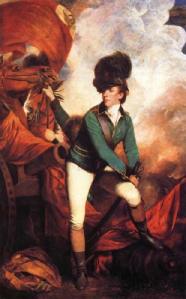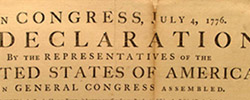Today marks the anniversary of the formation in 1775 of the Second Continental Congress, the body of delegates who met in Philadelphia during the American Revolutionary War. The Second Congress was for all purposes a de facto national government of the United States once independence was declared. It is the “Congress of Independence” that drafted and approved the Declaration of Independence, but it also appointed George Washington as commander-in-chief of the Continental Army and signed treaties with the foreign powers that supported the revolution. Most notably, the Second Congress issued the Model Treaty with France, our staunchest foreign ally during the war. The document became the guide for all subsequent commercial treaties.
In hindsight, one of the most striking qualities of the Second Congress is its reluctance toward revolution and independence. Most Americans – even many of the Founders who mobilized the Second Continental Congress – continued to cling to the hope even after open warfare broke out that there could be some kind of reconciliation with Great Britain. Although the waffling colonists chafed considerably under the paternalism of the mother country and resented Parliament’s obstinate refusal to compromise, many still believed that British rule was preferable to the return of French power to North America. Americans might hate the fact that the Crown quartered troops in Boston homes, but they hated the threat of French soldiers taking their homes and their women even more. Despite the economic hardships levied on the colonies by the Intolerable Acts in the early 1770s and the shots fired at Lexington and Concord in April 1775, Congress issued the Olive Branch Petition, which professed continued loyalty to the king and love for the mother country.
In the early months of 1776, the advantages of imperial protection still held enough sway that Thomas Paine dedicated a large portion of Common Sense (the pamphlet which widely popularized the idea of American independence for the first time) to fanning the flames of outrage against crown and Parliament. In fact, an entire section of the pamphlet is an elaborate, almost begging entreaty to American readers, asking them to accept the common sense of the matter at hand, namely the need to abandon king and country and listen as “the blood of the slain, the weeping voice of nature cries, ‘TIS TIME TO PART.” Paine needed to apply all of his consummate skills as the most persuasive member of the Revolution’s “chattering class” to the task of convincing readers of the necessity of independence 10 months after the Americans had entered a bloody fight with the 18th century’s global superpower, the same power that many of them hoped would protect them from a traditional enemy.
However, by the beginning of 1776 events accelerated. Ordinary colonists as well as the small but active and vocal minority that advocated separation decided that they were fighting a war for independence.
Towns and legislatures in Massachusetts, Rhode Island, Connecticut, and Virginia began to debate the wisdom of independence, asking the people for their opinions on the subject and whether they would be willing to support such a radical move with their lives and fortune. Similar discussions soon followed in every colony. This was an unprecedented move in itself: even the history of English rights and liberties contained nothing like a poll for regime change mobilized from the ground up. However, it became obvious that there was significant support for an independence movement. Six months earlier the wide scope of a debate about independence would have been unlikely. Congress could at last be confident that they would not be ahead of the people when it came to a revolutionary war. The “reluctant revolutionaries” at last declared that they were Americans.






Happy Fourth of July
A portrayal of the Second Continental Congress and the adoption of the Declaration of Independence, July 4, 1776.
It is worth your time some time today between attending Fourth of July parades and the requisite grilling as part of a federal holiday barbecue to read Brian Vanyo’s essay “What Do We Celebrate on the Fourth of July?” Vanyo, an author and board member of the Constitution Leadership Initiative, points out that our national founding principles include strong leanings toward limited government power and a call to the people to resist encroachments on their rights by a swollen government. Mr. Vanyo and I sing from the same choir book, as my recent essay re-posted on RealClearHistory discusses how the current administration has twisted the classic meaning of equality in the Declaration.
Vanyo writes, “The domineering government we have today was never the design of our founders — in the words of Thomas Jefferson and James Madison, ‘An elective despotism was not the government we fought for.’ But the government we have today needs not be the government we keep. By the principles of our founding, we have the power to change our government and secure our inalienable rights.” That’s an idea worth re-discovering today, an idea far more important to the Fourth of July than the condition of any burger fresh off the grill.
6 Comments
Filed under Commentary, History of the Declaration of Independence
Tagged as American Revolution, Brian Vanyo, Declaration of Independence, equality, Fourth of July, limited government, Paul Huard, Revolutionary War, Second Continental Congress